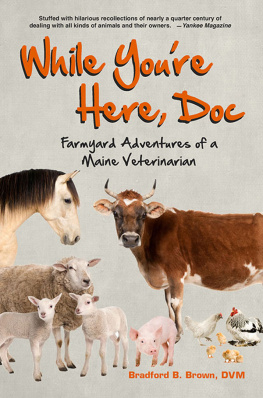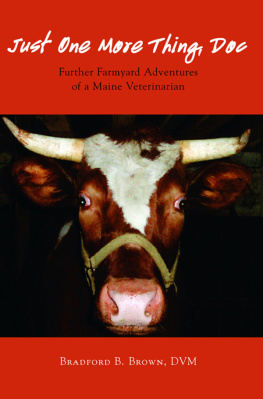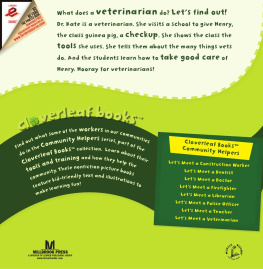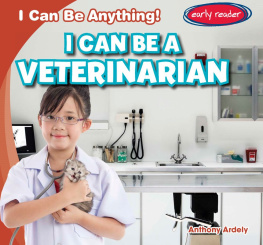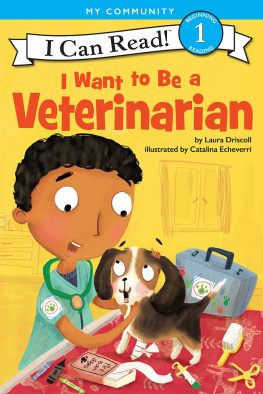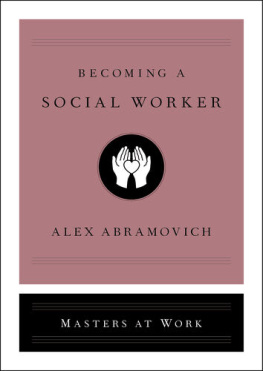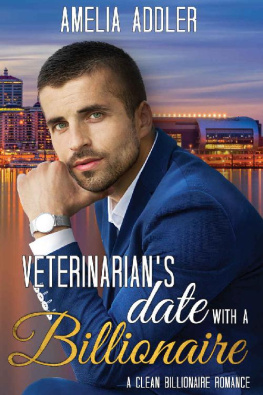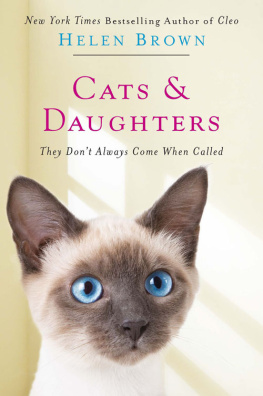While Youre Here, Doc

Farmyard Adventures of a Maine Veterinarian
Bradford B. Brown, DVM

T ILBURY H OUSE , P UBLISHERS
103 Brunswick Avenue
Gardiner, Maine 04345
800-582-1899 www.tilburyhouse.com
Copyright 2006 by Bradford B. Brown, DVM
First paperback printing, April 2006
10 9 8 7 6 5 4 3
E-book, May 2013; ISBN 978-0-88448-347-2
All rights reserved. No part of this book may be reproduced in any form or by any electronic or mechanic means including information storage and retrieval systems, without permission in writing from the publisher, except by a reviewer who may quote brief passages in a review.
The names and other identifying details of the characters in this book have been changed to protect individual privacy.
Library of Congress Cataloging-in-Publication Data
Brown, Bradford B., 1929
While youre here, Doc : farmyard adventures of a Maine veterinarian / Bradford B. Brown.
p. cm.
ISBN-13: 978-0-88448-279-6 (pbk. : alk. paper)
ISBN-10: 0-88448-279-0 (pbk. : alk. paper)
1. Brown, Bradford B., 1929- 2. VeterinariansMaineBiography. 3. Domestic animalsMaineAnecdotes. 4. Veterinary medicineMaineAnecdotes. I. Title.
SF613.B76A3 2006
636.089092dc22
2005032418
Cover design by Janet Robbins of North Wind Design & Production; image from Djk/Dreamstime.com.
Farm Calls photo section and author photo by Lou Garbus
Text designed on Crummett Mountain by Edith Allard, Somerville, Maine
Printed and bound by Versa Press, East Peoria, Illinois
To all the animals that made it possible
To the memory of my brother, colleague, and father figure,
Philip R. Brown, DVM
To my mother, Hazel Crosby Brown
To my three children,
Jane Roy Brown,
Jeffrey Philip Brown,
and Laurah Jean Brown
To Francis H. Fox, DVM.
the best teacher I ever had
Contents

Veterinarians in the family: Dr. Neal C. Brown (standing left), Dr. Bradford B. Brown (right), and Dr. Philip R. Brown (seated), with their mother, Hazel C. Brown. Courtesy of the author.
Preface
This book is about my twenty-three years of veterinary practice, treating animals large and small, in Belfast, Maine, then a town of 5,000 people on Penobscot Bay. In the 1950s and 60s my brother Phil and I ran a small-animal hospital and made hundreds of farm calls to the dairy herds that dotted the Maine countryside.
Phil, my oldest brother, had been very generous in helping me financially during my four years at Cornell University College of Veterinary Medicine, and I joined him in 1956, right after graduating. My youngest brother, Neal, who also graduated from Cornell vet school in 1962, joined our Belfast practice briefly, but then left to pursue a Ph.D. in pharmacology at the Yale University School of Medicine. Subsequently, he became professor and founding chair of the Department of Pharmacology at the University of Massachusetts School of Medicine. Phil and I worked together until 1968, when he left the practice. I kept it up on my own for another ten years, running the small-animal hospital and making farm rounds in three counties.
My days in practice were full of physical and emotional challenges. When I joined Phil, our practice was about 30 percent small animalthe veterinary term for pets, chiefly dogs and cats. The large-animal sidehorses, pigs, goats, sheep, and mainly dairy cows, in those daysinvolved driving to farms within a forty-mile radius of Belfast, and sometimes wed travel as far as a hundred miles if the vet who served a distant town couldnt get there.
My large- and small-animal clients gave me very different experiences. Though farmers can be sentimental about their cows and horses and sheep, more often they treat them as a business commodity. If its going to cost $100 to operate on a cow thats worth $400 as a milker, and the farmer can get $300 for beefing herselling her for meathe doesnt have much use for your scalpel.
Pet owners, of course, viewed their animals as beloved companions. Here I had the chance to practice medicine much the way human physicians do, with many more choices about treatment. People with a sick dog or cat would, I found, often spend their last dime to save the animal. I certainly never exploited that, but I mention it because it meant that I was able to exercise some of my skills, such as some fairly complicated surgery, and explore treatment options that the frugal farmers of that time and place could rarely afford.
This book focuses on the farm side of my practice. The farmers in coastal Maine at the time were conservative, pragmatic, and frugal. While some were well educated, many were not, and they remained suspicious of new people, new methods, and new technology. Often they had grown up without ever leaving their ancestral homestead, repeating the generational struggle against the two most unpredictable forces in the natural world: weather, and flesh and blood. Most of them tried to eke a living out of small-to-middling-size dairy herds, Holsteins for the most part, because the notoriously stony soil along the coast gave them few options to grow cash crops. Any open farmland was used to grow hay and corn silage for cattle feed.
I understood that well enough. Along with four brothers and a sister, I grew up in the 1930s and 40s on a farm in Vassalboro, Maine. A rural village of pastures and farmsteads in the Kennebec River Valley, Vassalboro was then no more than a speck on the map between Augusta and Waterville. Some people recall that its the town mentioned in the Bert and I joke, when the city fella drives up to a farmer and asks how to get to Vassalboro. Dont you move a goddamned inch, the farmer replies.
On our farm, we kept dairy cows, pigs, sheep, chickens, and horses, not to mention assorted dogs and cats. (I have no doubt that growing up in the company of so many animals was the reason why two of my brothers and Ithree out of six childrenwent on to study veterinary medicine.) The only cash crop we raised was dry beans. The proceeds were used to pay real-estate taxes and other absolute necessities. Other cash was scarce, as my father made it clear one day when he gathered the four of us boys into the living room of our farmhouse. Our ages spanned seven to eleven, and we were somber. What had we done now? My father didnt mince words. To get through this life, to feed yourself and make a living, either youre born rich, or youre going to have to work, he began. I thought at this point in your lives Id better give you the news: you werent born rich.
That was surely true, but we had what we needed, even in the depths of the Great Depression. We lived off the land. From the ages of five to ten, I did many tasks, mostly menial, on the farm. We would still have to do all the chores, which included the milking of course, and all the chores related to the well-being of cattle and workhorses. Before the farm was electrified in 1937, my brothers and I had to haul water from the brook, a quarter-mile south of the barn. This was labor-intensive in winter, especially during a storm. We had a wooden punga sled made of oak with large runners, pulled by two horseswith planks placed across it to hold six fifty-gallon drums. After drilling holes in the ice, we had to fill each of those by dropping twenty-quart pails into the brook. It seemed like the six barrels would never fill, but at least the horses were getting rest before hauling those barrels straight up the bank of the brook. In a blizzard they were completely covered with snow, as were we. We hauled pail after pail, hoping there would be enough water to go around that evening so we would not have to return to the brook that night. Back in the barn, we watered and groomed the workhorses, brought fresh timothy hay from the mow and apportioned it to the cattle and forked out a generous amount to the horses. My job then was to extinguish all the lanterns in the stable and wait five minutes to make sure they were completely out. During that time of darkness I felt completely at peace with the world. The barn was warm, the cattle enjoying their hay, and all was well. At last I opened the door and ran through the blizzard to the house and a sumptuous supper prepared from 100 percent homegrown ingredients. Looking back, such experiences reinforced my belief that farming and nature are one.

